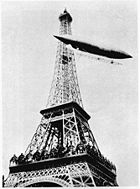
Santos-Dumont number 6
Encyclopedia

Airship
An airship or dirigible is a type of aerostat or "lighter-than-air aircraft" that can be steered and propelled through the air using rudders and propellers or other thrust mechanisms...
, designated as his #6, was designed and built by Alberto Santos-Dumont
Alberto Santos-Dumont
Alberto Santos-Dumont , was a Brazilian early pioneer of aviation. The heir of a wealthy family of coffee producers, Santos Dumont dedicated himself to science studies in Paris, France, where he spent most of his adult life....
. He used it to win the Deutsch prize in 1901. It is considered by many to be the first truly successful airship.
In April 1900, Henri Deutsch de la Meurthe
Henri Deutsch de la Meurthe
Henri Deutsch de la Meurthe was a successful French petroleum businessman and an avid supporter of early aviation...
offered the Deutsch de la Meurthe prize, also simply known as the "Deutsch prize", of 50,000 francs to the first machine capable of flying a round trip from the Parc Saint Cloud to the Eiffel Tower
Eiffel Tower
The Eiffel Tower is a puddle iron lattice tower located on the Champ de Mars in Paris. Built in 1889, it has become both a global icon of France and one of the most recognizable structures in the world...
in Paris
Paris
Paris is the capital and largest city in France, situated on the river Seine, in northern France, at the heart of the Île-de-France region...
and back in less than thirty minutes. The winner of the prize needed to maintain an average ground speed of at least 22 km/h (13.7 mph) to cover the round trip distance of 11 kilometres (6.8 mi) in the allotted time. The prize was to be available from May 1, 1900 to October 1, 1903.
To win the prize, Alberto Santos-Dumont
Alberto Santos-Dumont
Alberto Santos-Dumont , was a Brazilian early pioneer of aviation. The heir of a wealthy family of coffee producers, Santos Dumont dedicated himself to science studies in Paris, France, where he spent most of his adult life....
decided to build a balloon bigger than his earlier craft, the dirigible Number 5. On August 8, 1901 during one of his attempts, his dirigible lost hydrogen gas. It started to descend and was unable to clear the roof of the Trocadero Hotel. A large explosion was then heard. Santos-Dumont survived the explosion and was left hanging in a basket from the side of the hotel. With the help of the crowd he climbed to the roof without injury.
On October 19, 1901, after several attempts and trials, Santos-Dumont launched his Number 6 airship at 2:30 pm. After only nine minutes of flight, Santos-Dumont had rounded the Eiffel Tower, but then suffered an engine failure. To restart the engine, he had to climb back over the gondola rail without a safety harness. The attempt was successful, and he crossed the finish line in 29 minutes 30 seconds. Deutsch de La Meurthe immediately congratulated Santos-Dumont, but quickly a controversy broke out around a last minute rule change regarding the precise timing of the flight, and the timekeeper announced that the flight had failed the time limits by 40 seconds.
There was much public outcry from the crowds watching the flight, as well as comment in the press, but initially the prize was not awarded. Finally, after two weeks of vacillating by the committee of officials, Santos-Dumont was awarded the prize as well as the prize money of 50,000 francs. In a charitable gesture, he gave half the prize to he crew and then donated the other half to the poor of Paris.

